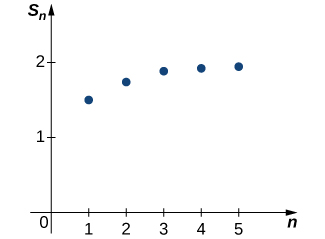| << Chapter < Page | Chapter >> Page > |
Plotting some of these values in [link] , it appears that the sequence could be approaching 2.

Let’s look for more convincing evidence. In the following table, we list the values of for several values of
These data supply more evidence suggesting that the sequence converges to Later we will provide an analytic argument that can be used to prove that For now, we rely on the numerical and graphical data to convince ourselves that the sequence of partial sums does actually converge to Since this sequence of partial sums converges to we say the infinite series converges to and write
Returning to the question about the oil in the lake, since this infinite series converges to we conclude that the amount of oil in the lake will get arbitrarily close to gallons as the amount of time gets sufficiently large.
This series is an example of a geometric series. We discuss geometric series in more detail later in this section. First, we summarize what it means for an infinite series to converge.
An infinite series is an expression of the form
For each positive integer the sum
is called the partial sum of the infinite series. The partial sums form a sequence If the sequence of partial sums converges to a real number the infinite series converges. If we can describe the convergence of a series to we call the sum of the series, and we write
If the sequence of partial sums diverges, we have the divergence of a series .
This website shows a more whimsical approach to series.
Note that the index for a series need not begin with but can begin with any value. For example, the series
can also be written as
Often it is convenient for the index to begin at so if for some reason it begins at a different value, we can reindex by making a change of variables. For example, consider the series
By introducing the variable so that we can rewrite the series as
For each of the following series, use the sequence of partial sums to determine whether the series converges or diverges.

Notification Switch
Would you like to follow the 'Calculus volume 2' conversation and receive update notifications?